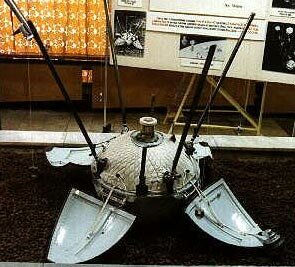

Оглавление РефератыThe Moon2.3) Luna OrbiterLuna 9 (Luna E-6)
Manufacturer's Designation: E-6. Class: Planetary. Type: Lunar. Nation: USSR. Agency: RVSN. Manufacturer: Korolev. E-6 probes were designed by Korolev's OKB-1 with the objective of making the first soft landing on the moon and beaming back pictures of the surface. Work began on the E-6 on 26 March 1960. The spacecraft consisted of: Two-part air bag system for landing the payload on the surface of the moon. The landed spacecraft itself was ejected from the main bus just above the surface; it was surrounded by this air bag to absorb the impact. ALS Automatic lunar station, the lander itself. The petals of the outer carapace of this capsule opened like a flower, pushing the photo platform above the surface. It was a hermetically sealed container with radio equipment, a program timing device, heat control systems, scientific apparatus, power sources, and a television system. After landing the four petals opened outward and stabilised the spacecraft on the lunar surface. Spring-controlled antennas assumed operating positions, and the television camera rotating mirror system, which operated by revolving and tilting, began a photographic survey of the lunar environment. During the flight to the moon the spacecraft was oriented by the KTDU's SAV astronavigation system. This used five sensors (two earth, two moon, one sun) to determine the orientation of the spacecraft in relation to these three celestial objects. At 8,300 km from the lunar surface the SAV was used to determine the local vertical in relation to the moon, gyroscopes were spun up and memorised the position. 75 km above the surface the KTDU ignited. At 25 km from the surface the landing bag inflated to one atmosphere pressure, and the main engine shut off. The landing bag was ejected by a sensor just before impact with the moon, and hit the surface at 15 m/s. The spacecraft had a launch mass of 1,470 kg and the ALS original design mass was 82 kg. In the modernised E-6M version the ALS mass was increased to 150 kg. There were 12 launches of the E-6 and E-6M, of which five experienced launch vehicle failures, four guidance system failures, and three resulted in successful landings. Luna 10 / E-6S |
|
Конкурс рефератов: Тема: The Moon Автор : БАННЕРЫ: |

